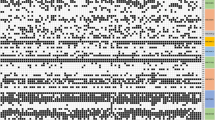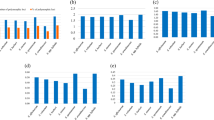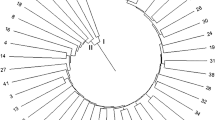Abstract
Sugarcane (Saccharum spp. hybrids) is an important sugar and renewable bio-energy crop with a high aneu-polyploidy and complex genome. The complex characteristics of sugarcane genome enhance the difficulty of selecting elite varieties in sugarcane breeding program. The objectives of this study were to establish the molecular identities (ID) of 91 nationally or provincially released Chinese sugarcane varieties and to evaluate the extent of genetic diversity among these varieties using SSR DNA markers and two fingerprinting systems, i.e., capillary electrophoresis (CE) and polyacrylamide gel electrophoresis (PAGE). A total of 151 SSR alleles together with 20 new alleles were detected by CE and 117 SSR alleles were detected by PAGE. Primer pairs SMC336BS, SMC31CUQ, and SMC597CS amplified more than eight alleles detectable by either CE or PAGE. Polymorphism information content (PIC) values of the SSR markers varied from 0.71-0.98 with an average of 0.90 for CE, or from 0.55-0.95 with an average of 0.84 for PAGE. UPGMA method classified the 91 varieties based on the CE data into four major groups with pair-wise similarity coefficients ranging from 58% to 95%. The genetic similarity estimates within and between the four groups varied from 0.31 to 0.87, with a mean of 0.49. Our results illustrated that the 21 SSR primer pairs in combination with CE or PAGE detection system could be a very useful working tool for molecular identification of sugarcane varieties, genetic diversity assessment, and parental selection in sugarcane breeding.




Similar content being viewed by others
References
Agarwal M, Shrivastava N, Padh H (2008) Advances in molecular marker techniques and their applications in plant sciences. Plant Cell Rep 27:617–631
Arif IA, Bakir MA, Khan HA, Al Farhan AH, Al Homaidan AA, Bahkali AH, Sadoon MA, Shobrak M (2010) A brief review of molecular techniques to assess plant diversity. Int J Mol Sci 11:2079–2096
Casu RE, Manners JM, Bonnett GD, Jackson PA, McIntyre CL, Dunne R, Chapman SC, Rae AL, Grof CPL (2005) Genomics approaches for identification of genes determining important traits in sugarcane. Field Crop Res 92:137–147
Chen PH, Pan YB, Chen RK, Xu LP, Chen YQ (2009) SSR marker-based analysis of genetic relatedness among sugarcane cultivars (Saccharum spp. hybrids) from breeding programs in China and other countries. Sugar Tech 11:347–354
Cordeiro GM, Taylor GO, Henry RJ (2000) Characterization of microsatellite markers from sugarcane (Saccharum sp.), a highly polyploid species. Plant Sci 155:161–168
Cordeiro GM, Pan YB, Henry RJ (2003) Sugarcane microsatellites for the assessment of genetic diversity in sugarcane germplasm. Plant Sci 165:181–189
D’Hont A, Grivet L, Feldmann P, Rao P, Berding N, Glaszmann JC (1996) Characterisation of the double genome structure of modern sugarcane cultivars (Saccharum spp.) by molecular cytogenetics. Mol Gen Genet 250:405–413
da Silva JAG (2001) Preliminary analysis of microsatellite markers derived from sugarcane expressed sequence tags (ESTs). Genet Mol Biol 24:155–159
Dos Santos JM, Duarte Filho LSC, Soriano ML, da Silva PP, Nascimento VX, de Souza Barbosa GV, Todaro AR, Ramalho Neto CE, Almeida C (2012) Genetic diversity of the main progenitors of sugarcane from the RIDESA germplasm bank using SSR markers. Ind Crop Prod 40:145–150
Doyle JJ, Doyle JL (1987) A rapid DNA isolation procedure for small quantities of fresh leaf tissue. Phytochem Bull 19:11–15
Fu YH, Pan YB, Lei CY, Grisham MP, Yang CL, Meng QY (2016) Genotype-specific microsatellite (SSR) markers for the sugarcane germplasm from the Karst Region of Guizhou, China. Am J Plant Sci 7:2209–2220
Grivet L, Arruda P (2001) Sugarcane genomics: depicting the complex genome of an important tropical crop. Curr Opin Plant Biol 5:122–127
Haq SU, Kumar P, Singh RK, Verma KS, Bhatt R, Sharma M, Kachhwaha S, Kothari SL (2016) Assessment of functional EST-SSR markers (sugarcane) in cross-species transferability, genetic diversity among poaceae plants, and bulk segregation analysis. Genet Res Int 2016:1–16
Heinz DJ, Tew TL (1987) Hybridization procedures. In: Heinz DJ (ed) Sugarcane Improvement through Breeding. Elsevier, Amsterdam, pp 313–342
Jaccard P (1908) Nouvelles recherché sur la distribution florale. Bull Soc Vaudoise Sci Nat 44:223–270
James BT, Chen C, Rudolph A, Swaminathan K, Murray JE, Na JK, Spence AK, Smith B, Hudson ME, Moose SP, Ming R (2012) Development of microsatellite markers in autopolyploid sugarcane and comparative analysis of conserved microsatellites in sorghum and sugarcane. Mol Breeding 30:661–669
Kalia RK, Rai MK, Kalia S, Singh R, Dhawan AK (2011) Microsatellite markers: an overview of the recent progress in plants. Euphytica 177:309–334
Korir NK, Han J, Shangguan L, Wang C, Kayesh E, Zhang Y, Fang J (2013) Plant variety and cultivar identification: advances and prospects. Crit Rev Biotechnol 33:111–125
Liu XL, Ma L, Chen XK, Ying XM, Cai Q, Liu JY, Wu CW (2010) Establishment of DNA fingerprint ID in sugarcane cultivars in Yunnan, China. Acta Agron Sin 36:202–210
Liu XL, Li XJ, Xu CH, Lin XQ, Deng ZH (2016) Genetic diversity of populations of Saccharum spontaneum with different ploidy levels using SSR molecular markers. Sugar Tech 18:365–372
Oliveira K, Pinto L, Marconi T, Margarido G, Pastina M, Teixeira L, Figueira A, Ulian E, Garcia A, Souza A (2007) Functional integrated genetic linkage map based on EST-markers for a sugarcane (Saccharum spp.) commercial cross. Mol Breeding 20:189–208
Oliveira KM, Pinto LR, Marconi TG, Mollinari M, Ulian EC, Chabregas SM, Falco MC, Burnquist W, Garcia AAF, Souza AP (2009) Characterization of new polymorphic functional markers for sugarcane. Genome 52:191–209
Pan YB (2010) Data basing molecular identities of sugarcane (Saccharum spp.) clones constructed with microsatellite (SSR) DNA markers. Am J Plant Sci 1:87–94
Pan YB, Cordeiro GM, Richard EP, Henry RJ (2003a) Molecular genotyping of sugarcane clones with microsatellite DNA markers. Maydica 48:319–329
Pan YB, Miller JD, Schnell RJ, Richard J (2003b) Application of microsatellite and RAPD fingerprints in the Florida sugarcane variety program. Sugar Cane Int (3/4):19–28
Pan YB, Tew TL, Schnell RJ, Viator RP, Richard EP, Grisham MP, White WH (2006) Microsatellite DNA marker-assisted selection of Saccharum spontaneum cytoplasm-derived germplasm. Sugar Tech 8:23–29
Pan YB, Scheffler B, Richard EP (2007) High-throughput genotyping of commercial sugarcane clones with microsatellite (SSR) DNA markers. Sugar Tech 9:176–181
Perera MF, Arias ME, Costilla D, Luque AC, García MB, Díaz Romero C, Racedo J, Ostengo S, Filippone MP, Cuenya MI, Castagnaro AP (2012) Genetic diversity assessment and genotype identification in sugarcane based on DNA markers and morphological traits. Euphytica 185:491–510
Pinto LR, Oliveira KM, Marconi T, Garcia AAF, Ulian EC, De Souza AP (2006) Characterization of novel sugarcane expressed sequence tag microsatellites and their comparison with genomic SSRs. Plant Breed 125:378–384
Powell W, Machray GC, Provan J (1996) Polymorphism revealed by simple sequence repeats. Trends Plant Sci 1:215–221
Qi YW, Pan YB, Lao FY, Zhang CM, Fan LN, He HY, Liu RA, Wang QN, Liu SM, Liu FY, Li QW, Deng HH (2012) Genetic structure and diversity of parental cultivars involved in China mainland sugarcane breeding programs as inferred from DNA microsatellites. J Integr Agr 11:1794–1803
Rohlf FJ (2000) NTSYS-pc: Numerical Taxonomy and Multivariate Analysis System, Version 2.1. Exeter Software, New York
Singh RK, Jena SN, Khan S, Yadav S, Banarjee N, Raghuvanshi S, Bhardwaj V, Dattamajumder SK, Kapur R, Solomon S, Swapna M, Srivastava S, Tyagi AK (2013) Development, cross-species/genera transferability of novel EST-SSR markers and their utility in revealing population structure and genetic diversity in sugarcane. Gene 524:309–329
Ukoskit K, Thipmongkolcharoen P, Chatwachirawong P (2012) Novel expressed sequence tag- simple sequencere peats (EST-SSR) markers characterized by new bioinformatic criteria reveal high genetic similarity in sugarcane (Saccharum spp.) breeding lines. Afr J Biotechnol 11:1337–1363
Varshney RK, Garner A, Sorells ME (2005) Genic microsatellite markers in plants: features and applications. Trends Biotechnol 23:48–55
You Q, Pan YB, Xu LP, Gao SW, Wang QN, Su YC, Yang YQ, Wu QB, Zhou DG, Que YX (2016) Genetic diversity analysis of sugarcane germplasm based on fluorescence-labeled simple sequence repeat markers and a capillary electrophoresis-based genotyping platform. Sugar Tech 18:380–390
Acknowledgements
This work was supported by an Earmark Fund from the China Agriculture Research System (CARS-170106 and CARS-170302) and the Major Science and Technology Project of Fujian Province, China (No. 2015NZ0002-2). We sincerely thank the Chinese sugarcane breeders in Guangxi Academy of Agricultural Science (Dr. Yang Rongzhong), Ganzhou sugarcane research Institute (Dr. Qi Yong-wen and Wang Qinnan), Yunnan Academy of Agricultural Science (Prof. Wu Caiwen), Guizhou Institute of Subtropical Crops (Dr. Lu Jiaju), and Fujian Academy of Agricultural Science (Prof. Pan Shimin) for suppling with the smpales of varieties.
Author information
Authors and Affiliations
Contributions
San-Ji Gao conceived the project and designed this work. Ali Ahmad and Jin-Da Wang performed the experiments, analyzed the data, and drafted the manuscript. Yong-Bao Pan performed interpretation of data and critical revision of the manuscript. Zu-Hu Deng, Zhi-Wei Chen and Ru-Kai Chen participated in revising the manuscript. All authors read and approved the final manuscript.
Corresponding authors
Ethics declarations
Conflict of Interest
The authors declare that they have no conflict of interest.
Additional information
Communicated by: Sithichoke Tangphatsornruang
Electronic Supplementary Material
ESM 1
(DOCX 43 kb)
Rights and permissions
About this article
Cite this article
Ali, A., Jin-Da, W., Yong-Bao, P. et al. Molecular Identification and Genetic Diversity Analysis of Chinese Sugarcane (Saccharum spp. Hybrids) Varieties using SSR Markers. Tropical Plant Biol. 10, 194–203 (2017). https://doi.org/10.1007/s12042-017-9195-6
Received:
Accepted:
Published:
Issue Date:
DOI: https://doi.org/10.1007/s12042-017-9195-6




